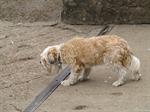
In dogs, aggressive behaviour generally manifests at about 6 months of age and normally withholds when the dog has reached around 4 years of age. For dog owners, dog aggression can become a problem. Lack of exercise is one of the main causes for aggression in domestic dogs as it limits their release of excess energy. They become frustrated from this imbalance and can cause serious injuries if this is not controlled in time.
Some dog breeds, like German Shepherds, can be naturally aggressive, especially if their owner encourages that behaviour (e.g. to train him as a guard dog). However, not all strains of one same dog breed are aggressive - some can be trained to be friendly to every family member but still be trained to guard the area.
Dogs are “pack animals” by nature, yet they have an amazing ability to learn if they are domesticated. Among their social pack unit, they can also feel distressed if they’re separated from the rest of the group. For instance, if the owner goes to work for the day and leaves the dog alone for a long period of time, the dog can get bored and frustrated, and easily get into mischief. If outside it may dig holes in the garden, eat any available plants (even if they’re poisonous or bad tasting), chew on objects e.g. garden furniture, shoes, or collect and spread rubbish from the bin to certain areas of the house.
They can also be very powerful and must be taught rules, boundaries and limitations to avoid dominance over their owners. Modifying a dog's behaviour, as well as fulfilling the dog's natural needs undoubtedly helps keep control of its aggressive comportment before it escalates. A dog should be taught that its owner is the “pack leader” and will, therefore, lead the “pack” (i.e. the owner walks in front and the dog behind).